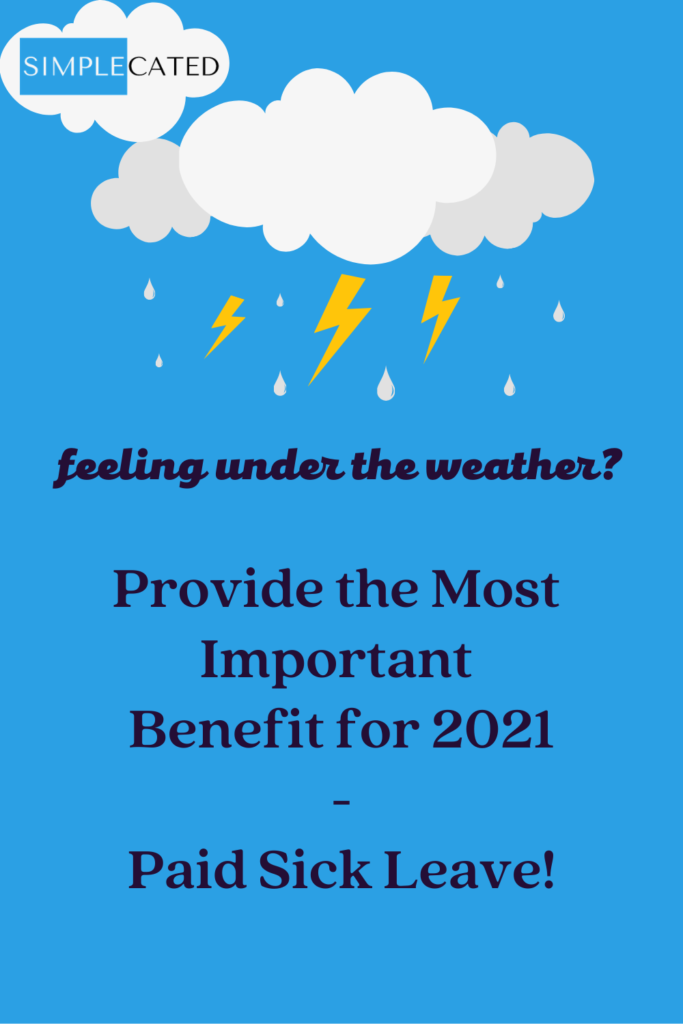2020 taught us a lot (perhaps the understatement of the year, right?). We learned a lot about ourselves, each other, and our workplaces. We learned what it truly means to support each other and be there for one another. In the process, we gained awareness about some workplace changes that may be needed. Now that we’re a full month into 2021, it’s time to put that learning into action. Even with the ongoing uncertainty of the pandemic, there are changes you can make today to improve your workplace. If you can only make one change this year, focus on paid sick leave. The most important benefit you can offer your employees is paid sick leave.
That answer may surprise you. You may have thought I would say something like more work from home or paid maternity leave (which you should absolutely provide). You also might have hoped for something a little more fun – a little more out-of-the-box. The fun stuff can come, but here’s what I’ve learned. If you don’t take care of your employees’ basic needs, then everything else loses its meaning. It may look pretty and appealing, but it lacks substance. And eventually, employees will see through it. You’ll lose your star performers, and your organization will never be as great as it could have been.
Why Paid Sick Leave Matters
COVID-19 has given us a reality check on contagious diseases. It has been so important for sick employees to stay home that the government provided paid sick leave. Through the FFCRA, companies with fewer than 500 employees were generally required to provide paid sick leave to their employees. What’s great is that this sick leave made a difference. One study has shown that the FFCRA’s paid sick leave provision resulted in 400 fewer COVID cases per state per day.
Employees have needed paid sick leave during this pandemic. Having access to paid sick leave and being encouraged/required to stay home when sick has made a huge difference. Sick employees haven’t had to choose between their health and a paycheck. Since sick employees have stayed home, others have stayed well and businesses have continued operating.
Here’s the thing, though – COVID isn’t the only contagious disease. We’ve all been around coworkers who still came to work when they had the flu or some other illness. We tried to avoid meeting with them or touching elevator buttons after them. (Let’s be honest – perhaps we’ve been that coworker who still went to work when sick.) I’m sure each of us can think of at least one time we caught a cold or illness from another coworker.
Outside of a pandemic scenario, there are lots of reasons employees still come to work when they’re sick. Those reasons won’t just go away. If employees don’t have access to paid sick leave, then pay is a huge part of why they come to work when sick. Even if employees do have paid sick leave, they may feel judged for using it or may have so much work piling up that they head back to the office.
The FFCRA’s paid leave requirements expired on December 31, 2020. Companies can still voluntarily provide FFCRA leave, and – good news – tax credits have been extended to March 31, 2021. However, we need to start looking long-term. Paid sick leave benefits everyone. Plus, it isn’t an expensive benefit to provide. It requires no additional money in your budget. Yes, you’re paying people to stay home, but you’re allowing them to focus on their health and wellbeing. They’ll return to work that much more productive and motivated. Plus, you’re protecting the rest of your employees. Having one employee out of the office is much better than half the department.
Developing a Paid Sick Leave Benefit
Here are some tips to get you started in developing a paid sick leave benefit. If you already offer sick leave to some or all of your employees, review this benefit and your workplace culture to see if there’s room for improvement.
- Sick Leave vs. PTO – Some companies have separate sick leave and vacation leave banks, while others lump everything together in the form of PTO (paid time off). There are pros and cons to each.
- Separate banks can cause more administrative work but can be helpful when an employee leaves. Companies tend to payout unused vacation (or are required to), but they aren’t required to payout sick leave. So, having separate banks can allow you to provide more leave. Employees who don’t get sick often may not like this route unless they have sufficient vacation leave.
- PTO can be easier to administer since everything comes out of the same bank. Make sure you provide enough PTO that employees can take appropriate vacation time and still have enough remaining for sick time. (I worked at one organization where I got 3 weeks of vacation and 2 weeks of sick leave, and then went to another organization where I got 3 weeks PTO.) There tends to be more focus on accruing time throughout the year. This helps when an employee leaves, since you can payout just the unused PTO that’s been accrued. Employees have more flexibility to use their time off as they need to. However, if you require PTO to be accrued, employees could wind up in a situation where they’re sick but don’t have PTO available.
- Include Part-Time Employees – Many companies offer paid sick leave to full-time employees but either prorate it for part-time or don’t offer it. Make sure your part-time employees receive an appropriate amount of paid sick leave. I think prorating can make sense – just make sure it results in an effective amount.
- Can Standalone – If all of your employees are part-time, it may be that you don’t currently offer vacation or sick leave. Just because you offer sick leave doesn’t mean you have to offer vacation leave. It’s a nice benefit to tack on, but you don’t have to if you’re not ready. You could start with sick leave now and see how it goes.
- Encourage Use – Somewhere along the way, we started thinking that dedication means working while sick. That our jobs might even be in jeopardy if we take a single sick day. Make sure your employees know you want them to stay home when they’re sick. Make sure your leaders reinforce this and set the example themselves by staying home when they’re sick. Behavior is much more impactful than words. If your boss tells you to stay home but always works when he’s sick, you’ll figure that the actual expectation is for you to do the same. Also, working from home does not exempt employees from sick leave! I know so many people who continue to work from home while sick. If an employee genuinely feels up to it, fine. But otherwise, they need to take care of themselves.
This year, one of the most important things you can do is make sure your employees have access to paid sick leave. By taking care of your employees’ basic needs, you show that you truly care about them. It costs you no additional budget money, but you gain employee appreciation, loyalty, dedication, and a healthier workforce!
Photo credit: By eag1e / Canva





